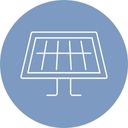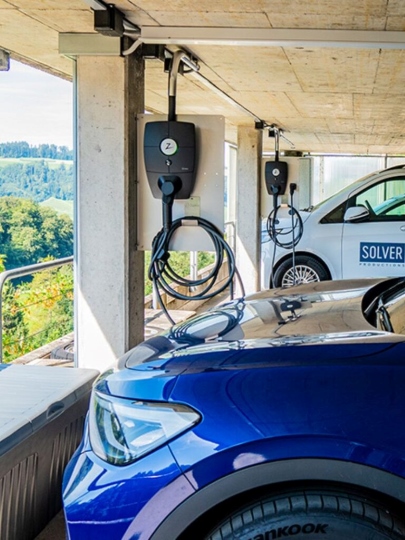OptimaSolar Worblental – A renewable energy cooperative success story
In the world of renewable energies, there are projects that not only have a positive ecological impact, but also strengthen the community. One such inspiring project is the Utzigenrain development, realized by the energy cooperative OptimaSolar Worblental. Their approach includes not only the generation of CO2-free electricity using a photovoltaic plant on the two park terrace roofs, but also the local sale of solar power to the property owners. This reference provides an insight into the success story of a cooperatively organized initiative that combines innovation and sustainability and makes the owners even better off financially.
The complex in Utzigenrain includes a total of 50 flats. A photovoltaic system with an area of around 550 m² was installed on the two car park terrace roofs in 2016. The system was financed with share certificates from 25 members of the OptimaSolar Worblental cooperative.
ZEV participants
The Utzigenrain owners’ association (EGU) joined together as soon as this was possible to form a self-consumption association (ZEV).

Optimization
- Boiler & e-charging stations
- planned by Gerber AG Energietechnik
- with systems from smart-me and Loxone

Photovoltaic system
- Solar panel area 550 m²
- Annual production 91’590 kWh
- Installed power 97.44 kWp
- Investment costs: CHF 190’000.-
OptimaSolar association members
25 members of the OptimaSolar Worblental energy cooperative have contributed to the financing of the PV system.

Paul Althaus
Co-founder of the OptimaSolar cooperative
By participating in the energy cooperative, each individual can help shape the energy transition and at the same time realise a return on their investment. Members of the cooperative receive a share in the association’s success. The annual interest paid out (similar to a dividend) on the share certificate is based on the business result and is redefined each year in accordance with a decision by the management.
The challenge of reducing peak loads
Prior to 2018, the technology for self-consumption associations was still in its early stages and was not legally regulated; for example, private smart meters could not yet be used for measuring with tariff models. On 21 May 2017, the Swiss electorate approved the new Energy Law. It is designed to reduce energy consumption, increase energy efficiency and promote renewable energies. This paved the way for a self-consumption community, as it was called at the time, and Paul Althaus examined various options for implementation. Paul Althaus explains: “Optimising self-consumption requires the use of advanced energy management systems and intelligent technologies.
Until a few years ago, there were hardly any solutions in this field. I lacked the real-time data to optimise the use of the PV system.” As project manager, Paul Althaus recognised that it was particularly important to efficiently control the large power consumers such as electric boilers and the new charging stations in order to increase self-consumption and thus profitability.
One urgent concern is the implementation of peak shaving. If residents of the complex use energy-intensive appliances such as electric cookers, heaters or air conditioning systems at the same time, this leads to a high demand for electricity. Due to high peak loads, the community of owners is forced to pay around CHF 700 per month to the energy supplier. The grid balance (see graph) clearly shows how the peak loads are caused by the switching of the boiler groups. The boiler load is already somewhat optimised, as it has been divided into four groups by the BKW control system. This problem will be exacerbated in future by electromobility. This is because the simultaneous charging of several electric vehicles can cause even greater peak loads.
Solution strategy
The integration of e-charging stations and boilers into the energy management of the complex requires careful planning and configuration in order to achieve the best possible results. In addition, the billing of 50 flats, in particular responding to customer enquiries, is relatively time-consuming.
Gerber AG Energietechnik therefore took over the Utzigenrain property on 1 January 2023. It is responsible for billing, carries out periodic system checks and makes suggestions for optimising self-consumption.
The metering concept takes into account not only the meters for the individual flats, but also the photovoltaic system, the e-charging stations and the boilers. The first MID meters from smart-me AG were successfully integrated into the project in 2018. The intelligent energy management system from smart-me, flexible tariff models in smart-me Billing and (by the end of 2023) the load control system from Loxone will be used to deal with peak loads and maximise self-consumption. These systems help to distribute and optimise electricity consumption in order to prevent overloads and thus reduce electricity costs for residents.
Peak shaving and intelligent load control
The most common strategy for increasing self-consumption is to control the heating of hot water. However, each apartment in the Utzigenrain has its own boiler, which makes optimization complex. Not only must the current photovoltaic production and the electricity demand of the boilers be taken into account, but logic must also be developed to determine when and at what level the boilers should be switched on/off in order to optimize self-consumption.
While simple optimizations can be implemented with the if/then actions of the smart-me cloud, the use of a third-party system is recommended for more complex optimizations. The 50 boilers in the development will therefore be regulated with Loxone in future. If the photovoltaic plant produces more energy than is currently required in the households, i.e. a “excess” is generated, the electric boilers are used as hot water storage tanks in the households. The logic is set up so that the electric use of the boilers is always activated when sufficient surplus electricity is available; grid electricity is only used in emergencies. Instead of feeding the surplus electricity into the grid at an unattractive price, it is now used to heat water. This increases self-consumption and the locally generated solar energy is stored in the hot water. Even more important, however, is the reduction in peak loads due to the staggered switching on of the boilers and thus the considerable cost savings.
The smart-me energy management system continuously monitors current energy generation and consumption. This information is transmitted live to Loxone. Loxone then in return sends the control signals to the smart-me meters, which regulate the boilers via the digital outputs. The data is transferred from smart-me to Loxone via an automatic API interface and does not generate any additional costs.

Markus Streit
Project Manager, Gerber AG Energietechnik
Implementing the boiler control system in this project was an exciting challenge. By precisely coordinating the systems, we were not only able to increase efficiency, but also reduce costs. It’s always impressive to see how intelligent technologies can make a real contribution to sustainability and cost-effectiveness.
The investment in Loxone will amortize within 3-4 years. Markus Streit has a precise overview of the peak load distribution and the resulting costs in the smart-me web portal. He used this data to show the community of owners the profitability of further optimizing the boiler loads with Loxone.

These ZEV e-charging stations are billed directly via smart-me billing.
Flexible tariff models
A further optimization concerns the control of the e-charging stations. The administration (EGU) has provided the basic installation and the ribbon cable, while the owners purchase the individual charging stations. The real-time data gives users precise insight into the charging current actually being used, i.e. whether it is coming from the photovoltaic plant or from the grid. As the charging stations are also billed with high, low and solar tariffs, users have an incentive to only charge their car when there is a photovoltaic excess. This means that over 80% of charging is done with locally produced photovoltaic electricity. As a result, the electricity from the photovoltaic plant is used directly for charging the electric vehicles, further reducing grid consumption.
The charging speed of the electric vehicles can also be adjusted. The Zaptec charging stations used can be regulated by Loxone with four levels. If the photovoltaic plant generates less electricity or the electricity consumption in the building increases, the charging power of the vehicles can be reduced to avoid expensive peak loads.
Cooperative success
By optimizing energy consumption and selling locally generated electricity, the photovoltaic plant from OptimaSolar Worblental will quickly achieve impressive results. Photovoltaic production, self-consumption and cost savings will increase significantly. The cost savings achieved through peak shaving alone will enable the cooperative to amortize all investments and services provided by Gerber AG Energietechnik within just five years.
However, the project is primarily characterized by its cooperative organizational structure and its pioneering spirit. The members of OptimaSolar Worblental invest their own capital to finance systems installed on rented roofs. The operation is financed by the sale of solar power and other additional services. Financial surpluses are used either as profit distributions or to return invested capital. This means that both the cooperative members and the participants in the self-consumption association benefit economically from this project.
“The Utzigenrain photovoltaic plant project with its own electricity consumption (EGU) has exceeded our expectations. We are proud to use locally generated renewable solar power and make a contribution to environmental protection. The cooperative organizational structure enables us to invest together in the future of renewable energies and achieve an appropriate return.” – Paul Althaus.
Furthermore, the Utzigenrain will be an exemplary ZEV optimized by our partner Gerber AG Energietechnik. As the self-generated solar power is used directly within the ZEV, the need for grid electricity is greatly reduced. This reduces participants’ electricity bills, as less electricity has to be drawn from the grid. This relieves the electricity grid, especially during peak load times, and contributes to grid stability. In addition, participants reduce their dependence on energy supply companies and the fluctuations in electricity prices on the market.

Stefan Fischer, Paul Althaus und Markus Streit (f.l.t.r)
Energy cooperatives are on a growth path
The overall aim of the OptimaSolar cooperative is to encourage the population to invest together in photovoltaic production and cover their own electricity needs with renewable energies. The project continues to grow and similar cooperatives have already been founded in other regions.
The legislator is also moving and it may be that in the future it will be possible to create associations for self-consumption (ZEV) regardless of their location. A new article, Art. 17bbisa StromVG, is intended to enable the formation of local electricity communities (LEG) in which neighborhoods, renewable energy producers and storage operators can join forces to supply each other with electricity. This fulfills a need similar to that of the association for own consumption (ZEV), but may also make use of the public grid. The participants must be in the same grid area and at the same grid level. This is intended to promote the increased expansion of renewable energy systems, particularly photovoltaic plants, so that they can be operated more profitably and the electricity generated can be used locally. As energy cooperatives are often more flexible and agile than energy suppliers, they can drive innovation in the energy sector. They can test new technologies, build efficient energy infrastructures and develop business models that meet the needs of society.
Write us
You are welcome to send us your request using the form below.
This site is protected by reCAPTCHA and the Google Privacy Policy and Terms of Service apply.
